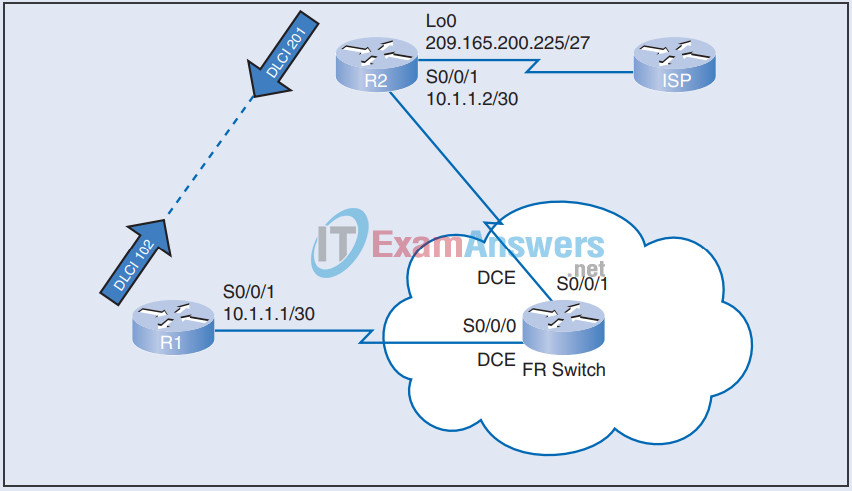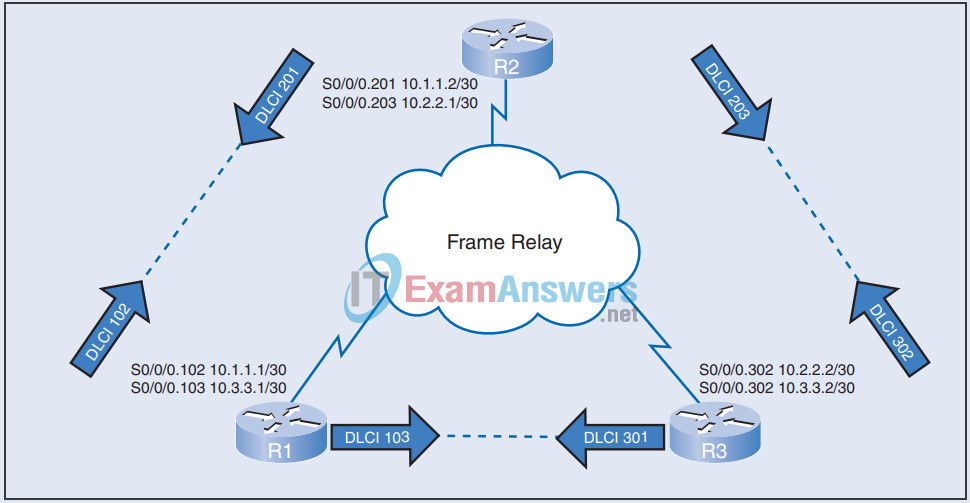1. What is used to identify the path to the next Frame Relay switch in a Frame Relay network?
Explanation: VCs are identified by DLCIs. DLCI values typically are assigned by the Frame Relay service provider (for example, the telephone company).
2. Why are Frame Relay paths referred to as virtual?
- There are no dedicated circuits to and from the Frame Relay carrier.
- Frame Relay PVCs are created and discarded on demand.
- The connections between PVC endpoints act like dialup circuits.
- There are no dedicated circuits inside the Frame Relay carrier cloud.
Explanation: Unlike leased lines, there are no dedicated circuits in the carrier’s Frame Relay network for end-to-end customer connectivity. Most providers use PVCs (some use SVCs) to create and discard circuits as customers purchase them without needing to deploy additional cabling.
3. Which statement accurately describes the split-horizon problem with regard to a multipoint topology?
- Split horizon must be disabled for all non-IP protocols.
- Split horizon creates IP routing loops in multipoint domains.
- Split horizon does not apply to broadcasts, so it does not protect protocols that use broadcast updates.
- Split horizon prevents any interface from accepting a valid update and forwarding to all the other interfaces.
Explanation: Whether using a single physical interface, or an interface configured as a multipoint subinterface, when the remote ends of the virtual circuits are on the same subnet, it is subject to split horizon. If point-to-point subinterfaces are used with each virtual circuit on a separate subnet, split horizon is no longer an issue.
4. Why is Frame Relay more cost-effective than leased lines? (Choose two.)
- Time division multiplexing
- It uses less equipment.
- Optimized packet routing
- It shares bandwidth across a large customer base.
- Dynamic IP addressing
Explanation: Frame Relay requires a single access line or circuit to the provider’s frame network cloud, regardless of the number of remote networks. A router with a single WAN interface and CSU/DSU is needed, along with a single access circuit. Frame Relay allows a provider to efficiently share the bandwidth within its cloud instead of deploying a large number of individual dedicated point-to-point links.
5. Match each status from the show frame-relay pvc command with its meaning:
Active
Inactive
Deleted
A. The DLCI is programmed in the Frame Relay switch, but the other end of the PVC may be down.
B. The DLCI does not exist on the router.
C. The DLCI is programmed in the Frame Relay switch and is usable.
D. The DLCI does not exist on the Frame Relay switch for this router.
E. The DLCI is programmed on the other end of the PVC for this router.
| Active |
The DLCI is programmed in the Frame Relay switch and is usable. |
| Inactive |
The DLCI is programmed in the Frame Relay switch, but the other end of the PVC may be down. |
| Deleted |
The DLCI does not exist on the Frame Relay switch for this router. |
6. What reliability advantage does Frame Relay offer over leased lines?
- Frame Relay access circuits are higher-grade circuits than leased lines.
- The pathways for virtual circuits inside the carrier are meshed.
- From end to end, a single virtual circuit uses a fixed error-checked path.
- Frame Relay uses more-sophisticated error-detection methods.
Explanation: A Frame Relay cloud typically is a meshed network of circuits and Layer 2 switches (usually ATM). This allows for redundancy within the provider’s network that does not exist with a dedicated leased line.
7. Refer to the exhibit. What is placed in the Address field of a frame that will travel from the Orlando office to the DC office?

- MAC address of the Orlando router
- MAC address of the DC router
- 192.168.1.25
- 192.168.1.26
- DLCI 100
- DLCI 200
Explanation: The Layer 2 encapsulation is Frame Relay, with the local DLCI used as the address.
8. Which situation favors a multipoint topology over point-to-point?
- When VLSM cannot be used to conserve addresses
- When using routing protocols other than IP
- When using a frame mesh topology to save access circuits
- When using a routing protocol that requires broadcast updates
Explanation: Point-to-point topologies typically requires a separate subnet for each point-to-point connection. In many networks VLSM is used to subnet one of the subnets as /30 networks. If this is not an option, multipoint topology can be used. Multipoint topology means that all the VCs share the same subnet address. (Note: In today’s modern networks, VLSM usually is an option.)
9. What is an advantage of configuring subinterfaces in a Frame Relay environment?
- It makes the DLCIs globally significant.
- It eliminates the need for using Inverse ARP.
- It solves split-horizon issues.
- It improves flow control and bandwidth usage.
Explanation: When point-to-point subinterfaces are used, each VC is on a separate subnet; therefore, split horizon is not an issue. From the perspective of the router, each VC is on a separate (logical) interface. This eliminates split horizon as an issue.
10. Which protocol can provide error correction for data that is transmitted over a Frame Relay link?
Explanation: Frame Relay does not provide any error correction. Only the upper-layer protocol TCP, used by the host, provides any error detection when Frame Relay is used as the Layer 2 transport.
11. Match each command with its description:
show interface
show frame-relay lmi
show frame-relay pvc
show frame-relay map
debug frame-relay lmi
A. Shows the status of the virtual circuit and FECN/BECN statistics
B. Verifies that the router and Frame Relay switch are sending and receiving LMI packets properly
C. Verifies encapsulation, LMI type, LMI DLCI, and LMI status
D. Verifies LMI statistics
E. Verifies the destination IP address mapping to the DLCI
| show interface |
Verifies encapsulation, LMI type, LMI DLCI, and LMI status |
| show frame-relay lmi |
Verifies LMI statistics |
| show frame-relay pvc |
Shows the status of the virtual circuit and FECN/BECN statistics |
| show frame-relay map |
Verifies the destination IP address mapping to the DLCI |
| debug frame-relay lmi |
Verifies that the router and Frame Relay switch are sending and receiving LMI packets properly |
12. At which rate does a service provider guarantee to transfer data into the Frame Relay network?
- Baud rate
- Timing rate
- Data transfer rate
- Committed information rate
Explanation: The CIR is the amount of data that the network receives from the access circuit. The service provider guarantees that the customer can send data at the CIR. All frames received at or below the CIR are accepted.
13. How are DLCI numbers assigned?
- They are assigned by a DLCI server.
- They are assigned arbitrarily by the user.
- They are assigned by the service provider.
- They are assigned based on the host IP address.
Explanation: The DLCI numbers are assigned by the service provider. Most providers allow the customer to choose its own DLCI numbers as long as they are valid numbers.
14. A router can reach multiple networks through a Frame Relay interface. How does the router know which DLCI to assign to the IP address of the destination network?
- It consults the Frame Relay map.
- It consults the routing table to find the DLCI.
- It uses Frame Relay switching tables to map DLCIs to IP addresses.
- It uses RARP to find the IP address of the corresponding DLCI.
Explanation: Frame Relay maps are used to map the remote network address to the local DLCI.
15. Match each term with its definition:
CIR
DE
FECN
BECN
A. A bit that marks the frame to be dropped when congestion is present
B. A bit set on every frame that a switch places on a congested link
C. The rate at which the service provider agrees to accept bits on the VC
D. A bit set on every frame that a switch receives on a congested link
| CIR |
The rate at which the service provider agrees to accept bits on the VC |
| DE |
A bit that marks the frame to be dropped when congestion is present |
| FECN |
A bit set on every frame that a switch places on a congested link |
| BECN |
A bit set on every frame that a switch receives on a congested link |
16. Compare and contrast the following terms: DLCI, LMI, and Inverse ARP.
DLCI: Data Link Connection Identifier
- VCs are identified by DLCIs, and the DLCI values are assigned by the Frame Relay service provider.
- Frame Relay DLCIs have local significance and no significance beyond the single link.
- A DLCI identifies a VC to the equipment at an endpoint.
LMI: Local Management Interface
- LMI is a keepalive mechanism that provides status information about Frame Relay connections between the router (DTE) and the Frame Relay switch (DCE).
- Cisco routers support three types of LMIs: Cisco, ANSI, and q933a.
Inverse ARP
- Inverse Address Resolution Protocol (ARP) obtains Layer 3 addresses of other stations from Layer 2 addresses, such as the DLCI in Frame Relay networks (which is the reverse of what ARP does).
- It is primarily used in Frame Relay and ATM networks, where Layer 2 addresses of VCs are sometimes obtained from Layer 2 signaling, and the corresponding Layer 3 addresses must be available before these VCs can be used.
17. Refer to the exhibit.

The following configuration is for router R1:
interface s0/0/1
ip address 10.1.1.1 255.255.255.252
encapsulation frame-relay
bandwidth 64
What command on R1 is required to statically configure a Frame Relay connection to R2? Traffic between sites must also support OSPF.
frame-relay map ip 10.1.1.2 102 broadcast
18. Compare and contrast the following terms: access rate, CIR, CBIR, and BE.
Access rate (or port speed)
- The capacity of the local loop.
- This line is charged based on the port speed between the DTE and the DCE (customer to service provider).
CIR: Committed Information Rate
- The capacity through the local loop guaranteed by the provider.
- Customers normally choose a CIR lower than the access rate to allow them to take advantage of bursts.
CBIR: Committed Burst Information Rate
- The maximum number of frames allowed in a burst.
- It cannot exceed the CIR for the link.
BE: Excess Burst
- The amount of data above the CBIR that the network tries to deliver, up to the maximum speed of the access link.
- Packets over CIR are marked discard eligible (DE), indicating that they may be dropped if the network does not have capacity.
19. Refer to the exhibit and the following configuration. R1 cannot establish connectivity with the routers over the Frame Relay cloud. What are the problems with this configuration?

hostname R1
interface s0/0/1
encapsulation frame-relay
!
interface s0/0/1.201 point-to-point
ip address 10.1.1.1 255.255.255.0
frame-relay interface-dlci 201
!
interface s0/0/1.301 point-to-point
ip address 10.3.3.1 255.255.255.0
frame-relay interface-dlci 301
!
On router R1
- The main serial interface and subinterfaces should be Serial 0/0/0, Serial 0/0/0.102, and Serial 0/0/0.103, respectively.
- The wrong subnet mask is applied to the subinterfaces. The subnet mask should be 255.255.255.252.
- The DLCIs in the frame-relay interface-dlci command should be 102 and 103, respectively.



